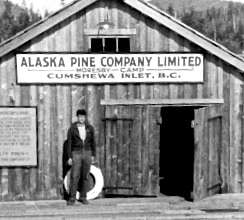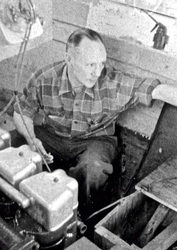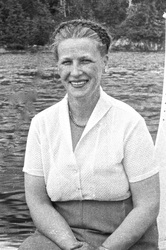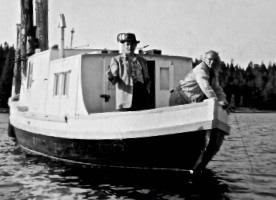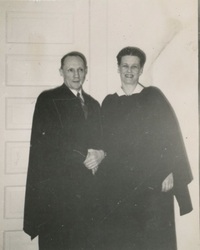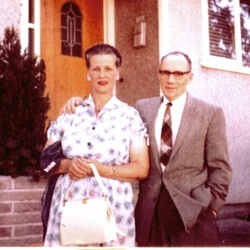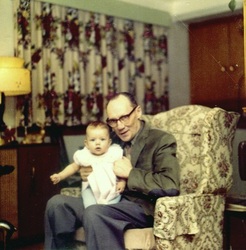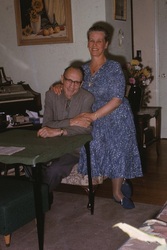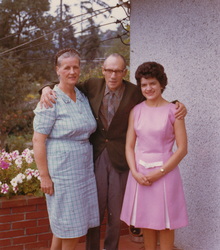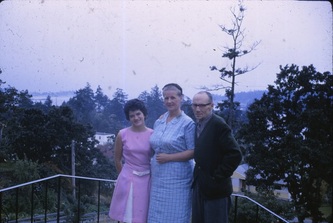Eleven - Prince Rupert & Victoria - Fini
1954
In Prince Rupert the family moved into a good-sized house at 345 5th Ave East purchased from Gordon Daniels for $10,000.00, and on December 1st Charles started work in the office as Supervising Draughtsman. Jim went into Grade 8, Ann to return to school in Grade 11, and Peter into Grade 13, all in Booth Memorial High School, the name of the secondary school at Prince Rupert in those days.
For much of his life Charles seems to have kept a diary of brief notes making a brief record of the events in his life. However, from the time he arrived in Prince Rupert, he seems to have lost this habit. So we really know nothing about how he may have had to adjust to the Prince Rupert Draughting Office.
Old friends in Prince Rupert included Arthur and Mary Martin, and Art’s brother, Dave and his wife Jean. They had known the Martins in Smithers when Charles had been the Assistant Ranger to the father of these two men, Ike, who had been the Forest Ranger. Another connection was that Ike was Charles predecessor as Supervising Draughtsman.
Dr. Gladstone Fiddes and his wife Dorothy who had lived in Hazelton and become good friends, at that time lived in Rupert, while two doors away from their new home was the home of Marion’s cousin, Dr. Jock Macdonald, with his wife Sybil and with whom Charles and Marion now renewed their old acquaintanceship. In the succeeding months not only did they enjoy visiting back and forth and becoming good friends once more, but Jock also became their family physician in Prince Rupert.
1954
In Prince Rupert the family moved into a good-sized house at 345 5th Ave East purchased from Gordon Daniels for $10,000.00, and on December 1st Charles started work in the office as Supervising Draughtsman. Jim went into Grade 8, Ann to return to school in Grade 11, and Peter into Grade 13, all in Booth Memorial High School, the name of the secondary school at Prince Rupert in those days.
For much of his life Charles seems to have kept a diary of brief notes making a brief record of the events in his life. However, from the time he arrived in Prince Rupert, he seems to have lost this habit. So we really know nothing about how he may have had to adjust to the Prince Rupert Draughting Office.
Old friends in Prince Rupert included Arthur and Mary Martin, and Art’s brother, Dave and his wife Jean. They had known the Martins in Smithers when Charles had been the Assistant Ranger to the father of these two men, Ike, who had been the Forest Ranger. Another connection was that Ike was Charles predecessor as Supervising Draughtsman.
Dr. Gladstone Fiddes and his wife Dorothy who had lived in Hazelton and become good friends, at that time lived in Rupert, while two doors away from their new home was the home of Marion’s cousin, Dr. Jock Macdonald, with his wife Sybil and with whom Charles and Marion now renewed their old acquaintanceship. In the succeeding months not only did they enjoy visiting back and forth and becoming good friends once more, but Jock also became their family physician in Prince Rupert.
Marion and Charles began attending the Anglican Cathedral where Charles soon found that he was playing the organ more than he had expected. As organist, and as in previous churches, he also led the choir. And as long as Peter was living in Prince Rupert he also participated in the church choir. Of particular note, one Sunday a very unfortunate and tragic event happened. He was, as usual, singing in the basis section on one side of the chancel, when during a hymn, Bishop Horace Watts, who was only a few feet from him, and who was participating in leading the service, suddenly collapsed. Instantly some of the older men sprang to his aid, and carefully lifting him, carried him past us into the vestry. The ambulance personnel soon arrived to take him to the hospital, but the poor man had suffered a heart attack and did not survive.
Having finally decided on a career choice - nursing - Ann returned to high school in Rupert, going into Grade Eleven in order to acquire the qualifications to join a nursing school. Also, Peter enrolled in Grade 13, the equivalent to the university’s First Year Arts program. As well as First Year Math and English he was able to take Grade Twelve Physics and Chemistry, which hadn’t been offered in Smithers. Also, Ann and Peter participated in a production of Gilbert and Sullivan’s “Mikado” which the school was doing that year.
Having finally decided on a career choice - nursing - Ann returned to high school in Rupert, going into Grade Eleven in order to acquire the qualifications to join a nursing school. Also, Peter enrolled in Grade 13, the equivalent to the university’s First Year Arts program. As well as First Year Math and English he was able to take Grade Twelve Physics and Chemistry, which hadn’t been offered in Smithers. Also, Ann and Peter participated in a production of Gilbert and Sullivan’s “Mikado” which the school was doing that year.
When summer came Peter wrote to the superintendent of Alaska Pine at Moresby Camp which was located in Cumshewa Inlet on the Charlottes. He accepted his application so at the end of June he flew to the airport at Sandspit, from which he was taken by a de Havilland Beaver to the camp. Then for two months he had a job of interesting, often very strenuous, and sometimes very dangerous work, setting chokers in a high-lead logging operation, and earning enough to register at UBC in the fall.
Meanwhile in Prince Rupert, one of Ann’s classmates, Arnold Moen, was hired by the Forest Service and reported for work in the Draughting Department to learn the methods of Forestry Draughting as Charles was able to teach it to him.
And while everyone else was making choices for their future, Jim decided that finishing high school wasn't really what he wanted to do. After discussing it with his parents, he decided to join the Royal Canadian Navy. So, after approaching the recruiters - probably in the local naval station, he was given a physical and other required tests and off he went to HMCS Cornwallis in New Waterford, Nova Scotia. To the rest of the family this placement sounded pretty exotic, but that was where he received his basic training, which was then followed by a series of assignments on a number of the Navy's ships.
Meanwhile in Prince Rupert, one of Ann’s classmates, Arnold Moen, was hired by the Forest Service and reported for work in the Draughting Department to learn the methods of Forestry Draughting as Charles was able to teach it to him.
And while everyone else was making choices for their future, Jim decided that finishing high school wasn't really what he wanted to do. After discussing it with his parents, he decided to join the Royal Canadian Navy. So, after approaching the recruiters - probably in the local naval station, he was given a physical and other required tests and off he went to HMCS Cornwallis in New Waterford, Nova Scotia. To the rest of the family this placement sounded pretty exotic, but that was where he received his basic training, which was then followed by a series of assignments on a number of the Navy's ships.
Charles continued to work in the Prince Rupert Draughting Office through 1955 to 1959. In 1956, having the urge to do some boating, and the need to find way to get into the outdoors, he bought a small boat about 18 or 20 feet long, powered by a good-sized outboard motor, and joined the Prince Rupert Yacht Club where he kept it tied up. The caretaker there, Steen Deedrickson, soon became a friend. With their boat he and Marion were able to get out on some summer Saturdays into a corner of the extensive Prince Rupert Harbour, where they would drop their anchor. Then they would lower two or three crab traps, and in a short while pull up several crabs which they would then cook right there on the boat.
But the boat you have is never big enough. In the fall Charles sold the outboard boat, and bought a small gillnetter, a retired fishing boat, about 28 0r 30 feet long. Back at the Yacht Club he removed the traditional fishing-boat cabin, and over the next few months – from the winter, extending into the spring – reolaced the one-cylinder Easthope engine with a three cylinder Easthope, built a new cabin on it, and renamed it the Char-Mar, after themselves, a custom which they found pleasure in adopting.
Once their "new" boat was seaworthy, and even before the cabin had been finished, Charles and Marion enjoyed taking it out for fishing and picnics. Gradually the boat’s cabin took shape, and with the more powerful three-cylinder engine, which Charles had installed, they were able to go along at a pretty good clip. On these small outings, they enjoyed taking along friends. Able to accommodate five or six friends, such as Art & Mary Martin and their family, they would find a beach where they would go ashore, build a fire and roast some wieners or cook some other delicious ingredient for supper.
Once their "new" boat was seaworthy, and even before the cabin had been finished, Charles and Marion enjoyed taking it out for fishing and picnics. Gradually the boat’s cabin took shape, and with the more powerful three-cylinder engine, which Charles had installed, they were able to go along at a pretty good clip. On these small outings, they enjoyed taking along friends. Able to accommodate five or six friends, such as Art & Mary Martin and their family, they would find a beach where they would go ashore, build a fire and roast some wieners or cook some other delicious ingredient for supper.
After a time Charles was approached by folk from the Prince Rupert United Church, and due to circumstances, (probably there was a competent successor waiting who could take over in the Cathedral) he felt he could leave the latter and answer this call to the United Church where they needed an organist and choir master.
At this point, a word or two (probably inadequate and to a degree inaccurate, because who of us really understands another), about Charles’ faith.
As has already been explained, Charles’ upbringing had been in both the Church of England (Anglican) and the Wesleyan Methodist (in Canada the United Church had been formed by the union of the Methodist, the Presbyterian and the Congregational churches). He had a strong faith that often had sustained him in the hardships of his adult life in Canada.
And the most difficult times of his life were when he had been struggling to make a living at Ootsa Lake, and then when he and Marion were struggling for the existence of the store in Hazelton. At Ootsa Lake he had arrived at the start of the Depression and then by taking many part-time jobs, worked at coping with the deepening decline in the economy when there were virtually no jobs in their region.
Many good workers who were looking for work had had to leave their homes for other parts of the country, while some people had little or no way to put food on their table. So Charles admitted to me that he had made finding ways to make a living a matter of prayer, and had always been able to find something to do – which paid either in cash or in kind, or was a dinner on the table and good company.
As he told me afterwards, in the midst of their most trying times in the store, when, if they hadn’t found the financial resources to meet their obligations they would have gone bankrupt, they had made their problems a matter of prayer. They had prayed to their Lord to send help. Up to then, the catches of salmon on the coast for several years just after the war had been meagre, and the fishermen and shore workers themselves had faced starvation. But subsequent to their offering up prayers to the Creator, the conditions had reversed, and the return to the fishermen had been phenomenally great. That year, with the very large catch, the cannery workers had many hours of work. Consequently, when the season was over and all the locals had returned to Hazelton from the coast, they had money in their pockets which they didn’t mind spending. They liked what they saw in our store, so that suddenly the Up-To-Date Store was solvent and they could pay their bills. And Marion and Charles were convinced that it was a miracle that had happened as a result of their prayers.
And as Charles told me, just because you can’t see God doesn’t mean that he doesn’t exist. He added, you can’t see radio waves or similar phenomena which are in the physical world, but we know they exist because we have devised instruments to detect them. And he was convinced that similarly, God was real, and had responded to their prayers.
Charles didn’t preach, he didn’t visit the sick in the hospital, or do any of the many “good works” that many conscientious church-goers do. But he served through his music. As accomplished at the keyboard as he was, he always put in at least a couple of hours going over the music for the Sunday service, so the choir and congregation would have well played quality music that added to and didn’t distract from the solemnity of the occasion.
Charles was also an excellent conversationalist. He had grown up with parents who were products of the land, and as such they had instilled in him a great respect for everyone around him - the labourers, farmers, small businessmen and professionals. Accordingly, he related easily to folks in many walks of life.
At this point, a word or two (probably inadequate and to a degree inaccurate, because who of us really understands another), about Charles’ faith.
As has already been explained, Charles’ upbringing had been in both the Church of England (Anglican) and the Wesleyan Methodist (in Canada the United Church had been formed by the union of the Methodist, the Presbyterian and the Congregational churches). He had a strong faith that often had sustained him in the hardships of his adult life in Canada.
And the most difficult times of his life were when he had been struggling to make a living at Ootsa Lake, and then when he and Marion were struggling for the existence of the store in Hazelton. At Ootsa Lake he had arrived at the start of the Depression and then by taking many part-time jobs, worked at coping with the deepening decline in the economy when there were virtually no jobs in their region.
Many good workers who were looking for work had had to leave their homes for other parts of the country, while some people had little or no way to put food on their table. So Charles admitted to me that he had made finding ways to make a living a matter of prayer, and had always been able to find something to do – which paid either in cash or in kind, or was a dinner on the table and good company.
As he told me afterwards, in the midst of their most trying times in the store, when, if they hadn’t found the financial resources to meet their obligations they would have gone bankrupt, they had made their problems a matter of prayer. They had prayed to their Lord to send help. Up to then, the catches of salmon on the coast for several years just after the war had been meagre, and the fishermen and shore workers themselves had faced starvation. But subsequent to their offering up prayers to the Creator, the conditions had reversed, and the return to the fishermen had been phenomenally great. That year, with the very large catch, the cannery workers had many hours of work. Consequently, when the season was over and all the locals had returned to Hazelton from the coast, they had money in their pockets which they didn’t mind spending. They liked what they saw in our store, so that suddenly the Up-To-Date Store was solvent and they could pay their bills. And Marion and Charles were convinced that it was a miracle that had happened as a result of their prayers.
And as Charles told me, just because you can’t see God doesn’t mean that he doesn’t exist. He added, you can’t see radio waves or similar phenomena which are in the physical world, but we know they exist because we have devised instruments to detect them. And he was convinced that similarly, God was real, and had responded to their prayers.
Charles didn’t preach, he didn’t visit the sick in the hospital, or do any of the many “good works” that many conscientious church-goers do. But he served through his music. As accomplished at the keyboard as he was, he always put in at least a couple of hours going over the music for the Sunday service, so the choir and congregation would have well played quality music that added to and didn’t distract from the solemnity of the occasion.
Charles was also an excellent conversationalist. He had grown up with parents who were products of the land, and as such they had instilled in him a great respect for everyone around him - the labourers, farmers, small businessmen and professionals. Accordingly, he related easily to folks in many walks of life.
One of the highlights of their stay in Prince Rupert happened in the summer of 1958. On that occasion Marion and Charles were invited to go with District Forester Percy Young and his wife, on a cruise on the Salt Mist, a 68 foot cabin cruiser built in 1929 in Vancouver and bought by the Forest Service for working with coastal logging companies. Their itinerary took them into a variety of inlets where Mr. Young inspected various logging operations. The voyage, which went as far south as Ocean Falls, was one of the highlights of their stay in Prince Rupert
In 1959 Marion and Charles' daughter Ann was to graduate from the Royal Jubilee Hospital School of Nursing in Victoria. On April 24, Marion and Charles left Prince Rupert for the south in their Vauxhall, to attend her graduation on May 3rd.
After the ceremony and a little visiting with Ann and some relatives, Charles and Marion left for home on May 5. While in Victoria in May it had become apparent to them that to live in Victoria with its gentle climate would be much easier on Charles, given his increasingly fragile condition.
Consequently, when they got home Charles applied for a move to the capital city. After waiting for a short time he was notified that he had been accepted for a position in the Victoria main office as Engineering Assistant under Bob Thomas and Pete Hemphill.
For this move once again they had to get busy on preparations. First he sold the Char-Mar to Tom Carscadden. Then, after several months they found a buyer for the house. It was sold in August to “Swede” Morse.
After getting rid of much of the excess stuff which the family had accumulated, they had packed everything and had moved out of the house by August 24th to a motel. Then after wrapping up a few more loose ends they left Prince Rupert by car for Victoria on August 29th.
Peter, who was home for the summer, and helped them with the packing and other tasks requiring “brute force”. Charles and Marion arrived in Victoria on Sept 1st. They looked at a few houses and bought one they liked at 2730 Asquith St., and moved in to it on September 16th.
After the ceremony and a little visiting with Ann and some relatives, Charles and Marion left for home on May 5. While in Victoria in May it had become apparent to them that to live in Victoria with its gentle climate would be much easier on Charles, given his increasingly fragile condition.
Consequently, when they got home Charles applied for a move to the capital city. After waiting for a short time he was notified that he had been accepted for a position in the Victoria main office as Engineering Assistant under Bob Thomas and Pete Hemphill.
For this move once again they had to get busy on preparations. First he sold the Char-Mar to Tom Carscadden. Then, after several months they found a buyer for the house. It was sold in August to “Swede” Morse.
After getting rid of much of the excess stuff which the family had accumulated, they had packed everything and had moved out of the house by August 24th to a motel. Then after wrapping up a few more loose ends they left Prince Rupert by car for Victoria on August 29th.
Peter, who was home for the summer, and helped them with the packing and other tasks requiring “brute force”. Charles and Marion arrived in Victoria on Sept 1st. They looked at a few houses and bought one they liked at 2730 Asquith St., and moved in to it on September 16th.
Charles had already started work with the Engineering Services on September 8th and found that he would be working with a good bunch of fellows.
And their three "children" created some notable events in the lives of their parents, when during this period of time they decided that living alone wasn't what they wanted to do. Thus, within three years they all had found partners and married them. Peter to Muriel Wyrcimaga on 24 December 1960; Ann to William Robertson on 18 January 1961; and Jim to Sarah Law on 21 December 1963.
On September 1st 1962, Charles and Marion moved to 544 View Royal Avenue, a beautiful home with a view into one of the ocean inlets in the western part of Victoria where ships of the Royal Canadian Navy often anchored.
In Victoria, Marion and Charles attended the Anglican Church. Old friends, from Air Force days, Jim and Jean Cummings, with their son Clive, often came for visits.
After moving to their View Royal home Charles’ health had been gradually declining, making it harder and harder to live and perform the normal functions of life. Even performing the simplest tasks he quickly became breathless.
And their three "children" created some notable events in the lives of their parents, when during this period of time they decided that living alone wasn't what they wanted to do. Thus, within three years they all had found partners and married them. Peter to Muriel Wyrcimaga on 24 December 1960; Ann to William Robertson on 18 January 1961; and Jim to Sarah Law on 21 December 1963.
On September 1st 1962, Charles and Marion moved to 544 View Royal Avenue, a beautiful home with a view into one of the ocean inlets in the western part of Victoria where ships of the Royal Canadian Navy often anchored.
In Victoria, Marion and Charles attended the Anglican Church. Old friends, from Air Force days, Jim and Jean Cummings, with their son Clive, often came for visits.
After moving to their View Royal home Charles’ health had been gradually declining, making it harder and harder to live and perform the normal functions of life. Even performing the simplest tasks he quickly became breathless.
On Friday, February 28, 1964 Charles had a very bad emphysema attack.
After this event his condition had so worsened so that he was not able to return to work. Finally, on October 1st, 1964 he officially retired due to his asthma and emphysema.
After this event his condition had so worsened so that he was not able to return to work. Finally, on October 1st, 1964 he officially retired due to his asthma and emphysema.
Charles stayed at home with few outings for the next two years. His family visited when they could – Ann and Jim who lived in the area being very supportive and visiting frequently, while Peter and family who lived in Kamloops visiting when they could at Christmas and Easter. Finally on April 19, 1966, at the age of fifty-nine and a half, Charles Lucas Botham took his last breath, and found peace.
In looking back on his life, one can say that Charles was a very able, stubborn, and resourceful individual. Although being raised to a life of considerable privilege, he had coped quite adequately with the hardships of living in the BC backwoods while the Depression deepened in the country.
He volunteered for active service in wartime. He took the initiative of starting a business and prevailed in spite of difficult conditions. He married and started a family for which he never failed to provide.
If it had not been for the failure of his health, he would have enjoyed more material success, but as it was, he had more achievements in spite of those disadvantages than many do who fully retain their vigour.
Finally, he made many and good friends by dint of his personality and initiative, and he will live long both in the memories of those friends and his family, and in the genes which he passed on to his descendants.
He volunteered for active service in wartime. He took the initiative of starting a business and prevailed in spite of difficult conditions. He married and started a family for which he never failed to provide.
If it had not been for the failure of his health, he would have enjoyed more material success, but as it was, he had more achievements in spite of those disadvantages than many do who fully retain their vigour.
Finally, he made many and good friends by dint of his personality and initiative, and he will live long both in the memories of those friends and his family, and in the genes which he passed on to his descendants.
















